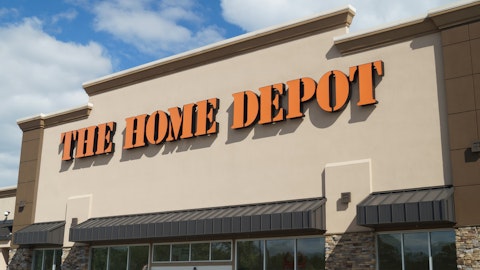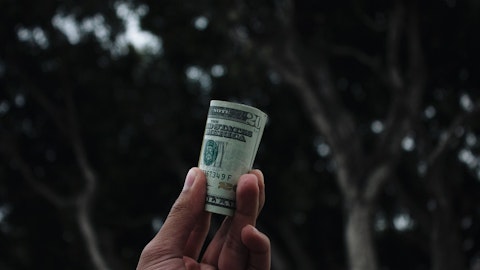Zachary Fadem: Got it. And then you mentioned that you would reinvest the legal settlement gain from Q1. So first of all, any color on what this reinvestment actually is or what it would look like? And then is it fair to say the investment will be largely in Q4? Or was there a part of that in Q3?
Richard McPhail: We’ve had part of that spent throughout the year. I think it is still a correct assumption that, that favorability will be fully offset by the end of the year. And so I really point you to our guidance as the best jumping off point for your modeling.
Operator: Our next question comes from the line of Scot Ciccarelli with Truist.
Scot Ciccarelli: So in some other retail verticals or a lot of other retail verticals, we’re seeing a return to pre-COVID purchasing patterns where you probably see more activity, purchasing activity on weekends and around holidays and events with, frankly, bigger lulls in between. So the questions are: one, are you seeing a similar general pattern? And two, assuming that is the case, are there ways for you guys to take advantage of that pattern from an operational standpoint to improve productivity?
William Bastek: Yes. Thanks for the question, Scot. It’s Billy. Listen, if it relates to different fluctuations in customer patterns and so forth, we haven’t seen that. It’s been very consistent throughout the quarter. And as Ted mentioned in his prepared remarks, really throughout the year when you account for some of the weather and some of the best effect we saw in the first half. So we haven’t seen that. Listen, if it relates to promotional activity whatsoever. We have events in our stores that we love to execute and drive excitement for our customers. But from a promotional activity standpoint, it’s really reverted back to pre-COVID times. Our pricing is certainly, as Ted mentioned, settled over the last several months. The environment certainly stabilized. So we operate in a very — we operate in a very rational market and promotional environment. As I said, this has returned to kind of pre-pandemic times.
Edward Decker: And we will always — Scot, we will always focus on EDLP. I mean we have events during certain seasons that they’re a lot of fun. They’re engaging with the associates. They’re engaging for our customers. But day in and day out, 12 months a year, we strive to be an EDLP retailer with great values every day.
Scot Ciccarelli: Got it. And then just a quick follow-up. On the big-ticket discretionary, is there any specific areas where you’re actually seeing a positive inflection? Or are they all still trending, call it, mid-single-digit negative?
Richard McPhail: No. We called out in my prepared remarks, categories like portable power and so forth, where we have seen great engagement. And candidly, we’re thrilled with the innovation that we continue to partner with our supplier base on that we bring to the market. And where we continue to see innovation, we continue to see great engagement with both the Pro and the consumer.
Operator: Our next question comes from the line of Chris Horvers with JPMorgan.
Christopher Horvers: So a couple of follow-ups to prior questions. My first one is, with the gross margin decline in the third quarter, can you talk a little bit about what drove that? You were lapping storm-related demand and you had some commodity deflation. So I would have thought that those would be positive. So is that fair? And what were the offsets to that drove it lower?
Richard McPhail: Thanks for the question, Chris. I’ll go back to Billy’s comments and Ted mentioned this as well, I think the most important observation we’ve made is that the worst of the inflationary environment is behind us. And as a result, as Billy said, retail prices are settling in the market. Some prices are settling at levels higher than 2022, others are settling lower. But we’re seeing some stabilization there that Billy can talk about. Specific to the quarter and gross margin, there are some timing differences as some prices settled ahead of anticipated product and transportation cost benefits that will come through as we turn through our inventory. But those are — I’d really sort of consider those timing. For the full year, our view on gross margin hasn’t changed and we expect to see slight pressure year-over-year. But Billy, maybe just talk about kind of the settling of prices.
William Bastek: Yes. I mean, as you mentioned, the inflation environment seems to be behind us. Prices absolutely settled in. And again, I reiterate what I said, work in a very rational market. And the other thing I’d add is this is no different than any other time frame, frankly. We have a portfolio approach to how we take on, whether it’s lumber deflation that we’ve talked a lot about throughout the year or other ins and outs as it relates to the P&L. So a very normalized environment, rational and really a stabilization that we’ve seen across the board as it relates to pricing.
Christopher Horvers: Got it. Got it, got it, got it. So that makes sense. And then on the variable cost side, you talked about a low single-digit leverage point historically and the $500 million of cost savings next year. You’ve had — at the same time, you’ve had negative transactions for quite some time now. So can you talk about where we are in terms of the — how labor can maybe become — how it becomes less variable over time, maybe in the context of the percentage of stores on minimum staffing levels. And if there is negative comps in ’24 or over the next 6 months, is the flexibility that you get from the $500 million offset by the fact that you’ll be — you could be having still negative transactions and less flexibility.





